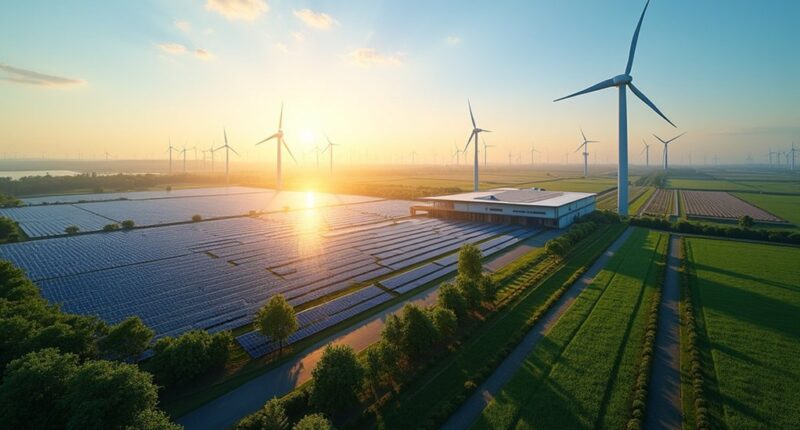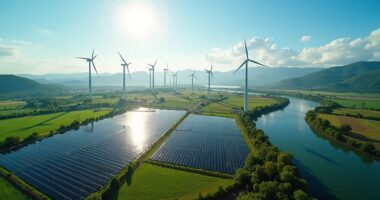Google and Meta are leading the charge with an $800 million green energy initiative aimed at transforming their AI data centers. They’re rolling out renewable solutions like on-site wind and solar power to cut carbon emissions and enhance energy efficiency. Picture a giant puzzle where every piece is a solar panel or wind turbine! This ambitious plan won’t just combat climate change; it’ll also support growing tech demands. Curious about how these giants are reshaping the energy landscape? There’s more to explore!
Quick Overview
- Google is investing $20 billion in sustainable energy solutions, including on-site renewable energy for data centers to combat climate change.
- Meta has secured 791 MW of new solar and wind power, expanding its renewable energy portfolio to meet AI energy demands.
- Both companies are co-locating facilities to minimize power interruptions and maximize the use of renewable energy sources.
- Their initiatives aim to transform data center operations by addressing carbon emissions and improving energy efficiency in the face of rising AI demands.
- With increasing corporate climate strategies, Google and Meta are shaping the future of energy needs through innovative sustainability efforts.
Google’s $20B Clean Energy Initiative and Its Impact on Data Centers
In a bold move that could reshape the landscape of tech infrastructure, Google has announced its ambitious $20 billion Clean Energy Initiative, aiming to transform how data centers operate across the United States.
Google’s $20 billion Clean Energy Initiative seeks to revolutionize data center operations across the U.S. with sustainable energy solutions.
This initiative will create industrial parks powered by on-site wind and solar plants, directly supplying clean energy to data centers. By co-locating these facilities, Google reduces reliance on traditional grids, cuts down on pesky power interruptions, and speeds up deployment. This initiative aims to evolve digital infrastructure with carbon-free energy. With plans to partially operationalize the first park by 2026, this initiative not only boosts gigawatt-scale data centers but also champions a greener future—one kilowatt at a time. Furthermore, the initiative is part of Google’s strategy to build $20 billion in renewable-energy and energy-storage assets by 2030.
These efforts represent a critical step toward addressing the growing carbon footprint of AI technologies, which require massive computational power and energy consumption to train and operate advanced models.
Meta’s Renewable Energy Commitments and AI Infrastructure Expansion
Meta’s commitment to renewable energy is like a welcome change in the tech world, especially as the demand for AI infrastructure surges. Recently, Meta secured 791 MW of new solar and wind power across four U.S. projects, boosting its renewable portfolio to 1,800 MW. With 28 global data centers and a target of adding 9.8 GW of renewables by 2025, Meta is racing to meet skyrocketing AI energy needs. Total partnership between Meta and Invenergy reaches 1,800MW demonstrates the scale of their investment in clean energy. Collaborating with tech giants, they’re also eyeing nuclear power to guarantee a steady, clean supply. This expansion of total renewable portfolio is crucial for addressing the rising demand for AI-driven data centers. This shift represents a critical step in the broader energy transition necessary to combat climate change and ensure a sustainable future. It’s like planting a garden, but instead of tomatoes, they’re growing a sustainable tech future!
The Role of Corporate Climate Strategies in Shaping Future Energy Needs
As corporations scramble to adapt to climate change, their strategies increasingly shape the energy landscape, much like a master chef crafting a new dish from a mix of surprising ingredients.
With government mandates pushing for carbon neutrality, tech giants are racing to meet ambitious renewable energy goals. By optimizing energy efficiency—think of it as trimming the fat off a steak—these companies aim for significant cost savings while lessening their environmental impact. Additionally, the increased demand for data centers due to AI and digital services is prompting these corporations to innovate and invest in sustainable energy solutions. Developing a sustainability assessment is crucial for businesses to identify their environmental impact and align green initiatives with core business objectives. Furthermore, as data centers demand skyrockets, corporate strategies are driving grid innovation and renewable investments, ensuring that the future of energy is as clean and efficient as a well-organized pantry. This shift towards renewable sources is essential, as data centres projected to account for 3.2 percent of worldwide carbon emissions by 2025.









